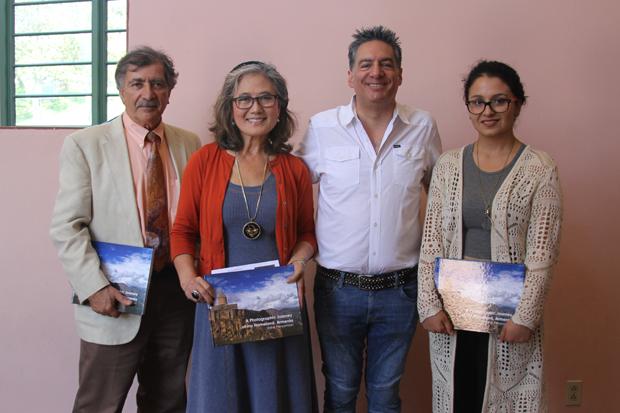Chronicles of Peroomian’s Travels
CULTURAL DIVERSITY: Professors Levon Marashlian and J.C. Moore, author Vahe Peroomian and Armenian Student Association President Astghik Hakobyan, left to right, pose with copies of “A Photographic Journey of my Homeland, Armenia.”
Kreider Hall was at capacity on Thursday when Community College Board of Trustees member Vahe Peroomian presented images from his book “A Photographic Journey of my Homeland, Armenia.”
GCC’s Armenian Student Association worked in conjunction with the Cultural Diversity Program to welcome Peroomian for the second-to-last installment of this semester’s lecture series, funded by the Foundation.
Sociology professor J.C. Moore, introduced the presentation as a commemoration of the Armenian Genocide. While the day of remembrance falls on April 24, Moore says events were extended so more people could learn about Armenia and its people.
Levon Marashlian, faculty adviser of ASA and history and political science professor, said they arranged the lecture to shine light on “modern Armenia … today’s Armenia” which is in a serious conflict right now with its neighboring country of Azerbaijan. The war between the two territories started in the early ‘90s, with a ceasefire in 1994, but Azeris attacked once again this year in early April.
Marashlian noted that the country itself is beautiful, but has gone through “all kinds of hardship.” Peroomian acknowledges some of these struggles in his book, but mostly focuses on the landscape and Armenia’s natural beauty.
Peroomian was born in the United States and he has lived in Iran, but has
visited Armenia several times, amassing a considerable portfolio of photographs. Besides the photographs, he keeps a log of his travels for future reference.
“Planning ahead, whether it’s Armenia or somewhere else far away, is enormous as far as photography,” Peroomian said.
He eventually compiled his notes and photographs — all strategically planned — from 2003 through 2011 and wrote 12 different stories about his travels which include the 2008 presidential election;his trip to Tsitsernakaberd, Armenia’s official genocide memorial; and the 20th anniversary of the republic. He felt compelled to put this book together after he realized how emotionally attached he was to Armenia.
Peroomian said he worked on it for about a year. “I’ve done everything on the book, from typesetting, to laying it out, to putting the photographs in, to actually sending it to the printer and choosing the cover. Beginning to end, it’s my work.”
His work was initially transformed into an essay that was published in “Asbarez,” an Armenian-American daily newspaper. That’s when he realized how much he loved writing about Armenia.
“Every trip I took after that, I started writing,” Peroomian said. “I wanted something to go along with the photographs to give them a voice and give the backstory of everything that happened.”
The text pairs well with the images as it explains his adventures and interactions with the locals. Though some stories are more surprising than others.
He described one instance where he visited Zorats Karer, a circle of stones near Sisian, and recalled its eerie-ness. After wandering the grounds for about 20 minutes, he met a man who became a shepherd after being a truck driver for many years. For some reason, Peroomian felt the urge to capture a photo of the shepherd who looked as ragged as the similarly shaped rocks that he leaned against.
He went back to the scene a year later and met with two other shepherds. He told them about the old shepherd he had met on his last visit and they said there had never been such a person there. The audience gasped in disbelief.
This was a significant moment in his journey because he had mentioned that he preferred not to photograph people — except for his kids, he said — but managed to get a shot of this man that no one else had seen before.
He said he hopes that revealing these stories about Armenians everchanging history will help people the country in a different light, specifically nature all around the world.
“For me, it was one of the numerous reminders that modern Armenia, as well as the historic Armenia, are full of wonders and no matter how much time passes there are more and more things to explore and learn about,” Astghik Hakobyan, president of ASA, said. “The old churches, khachkars, architecture and all the symbols that Vahe Peroomian found in Armenia prove how many undiscovered miracles the land has and it definitely increased my interest in Armenian history and culture.”
One of Peroomian’s many goals was photographing the Haghartsin Monastery in all four seasons. “I [took one] in the summer, spring and fall, all I needed was winter,” he said. “I had been there in the winter but wasn’t able to get to the monastery because the road was under construction.”
When he went back last time it had essentially be ruined, he said, because an Arab sheik who contributed to the restoration had replaced the unique metal roof with a stone roof that stripped it of its character.
He still went and took the photo, but it looked different from the rest. After that, Peroomian said Haghartsin became a place he didn’t look forward to. Once again, the audience let out a collective sigh upon hearing the news.
Based on his personal experience, he says that by travelling and going into uncharted territory, “you really get to know the people and experience the beauty of the land and that’s how you get to know the people … by breaking bread and making memories — but then you get to take pictures as well.”
He mentioned several times how much he loved trees due to their distinct features and said he mostly photographs Armenia’s vast terrains.
Photography is not Peroomian’s day job, but a hobby which he says takes up most of his free time. In fact, aside from being on the BOT at GCC, he teaches astronomy and physics at USC. That explains why he hasn’t had the time visit Armenia since last May, but he said plans to vacation there next year.
Reflecting on the present-day conflict between Armenia and Azerbaijan, Peroomian says: “It’s very difficult … having met the people in [Nagorno-Karabakh] and seeing how they live in such dire circumstances, especially in the border regions, I know that it impacts those people on a daily basis.”
After the presentation, students and faculty purchased copies of Peroomian’s book which he signed.
All proceeds from that day’s sales went to ASA. Hakobyan thanks Peroomian for his donation and said they’ll be using the $210 for future events — including Monday’s fundraiser where they’ll be selling Armenian food and dessert in Plaza Vaquero in an effort to raise money to support the bordering villages of Nagorno-Karabakh.
“A Photographic Journey of my Homeland, Armenia” has 226 pages of captivating visuals and information and is available for $49.99 on amazon.com.
Professor Marcia Wallerstein-Sibony will present “The Cultural Comparative Study of Armenians and Jews” from 12:20 to 1:30 p.m. in Kreider Hall Thursday. It is the last lecture for this semester.
The series will continue in the fall, with three presentations already scheduled. Visit glendale.edu and search “Road to Social Change” for more information.

Anahit Kardzhyan is working on her degree in print and digital journalism. She realized that a career involving writing and photography was for her after...

